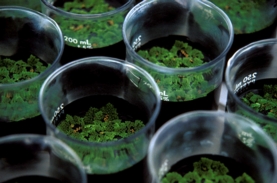
55 million years ago when the Earth was in a near-runaway climate state, dangerously overheated by greenhouse gases, the Arctic Ocean was a large lake connected to the greater oceans by the Turgay Sea.
Then 50 million years ago, the channel was blocked and that body of water suffered from a lack of exchange with outside waters and became a hot lake. But its waters were also then loaded with excess nutrients and that became the perfect habitat for a small-leaved fern called Azolla.
Azolla took advantage of the abundant nitrogen and carbon dioxide, two of its favorite foods, and flourished. Large populations formed thick mats that covered the body of the lake. When rainfall increased from the changing climate, flooding provided a thin layer of fresh water for Azolla to creep outward, over parts of the surrounding continents. And in doing so, this plant sucked up half of the CO2 in the air, creating a conveyor-belt-like effect of cold air that perpetuated ice and creating a succession of ice ages once the atmosphere's CO2 dropped below 600 ppm
Can the Fern That Cooled the Planet Do It Again? By Jennifer Huizen and ClimateWire, Scientific American
Azolla in petri dishes. Credit: IRRI Images via Wikimedia Commons



Comments